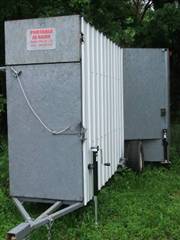

To send a message to an author, click on the author's name at the end of the article.
This Month in Ag Connection | Ag Connection - Other Issues Online
The new economic stimulus plan titled - The American Recovery and Reinvestment Act of 2009 (The 2009 Act) contains numerous tax provisions. It is reported that more than 50 major tax provisions have been rolled into The 2009 Act. Following are six major tax provisions that should be of general interest:
1) Section 179 capital asset expensing will be maintained at the $250,000 maximum deduction level for 2009. You may recall Section 179 was increased to the $250,000 level last year as part of a 2008 stimulus package. The 2009 Act is simply extending this larger deduction for another year. Remember that qualifying assets for Section 179 can be new or used.
2) The 50 percent bonus depreciation on the purchase of new qualifying assets is being extended through December 31, 2009. Bonus depreciation was implemented as part of last year's 2008 stimulus package. Qualified assets for bonus depreciation are assets that meet the following three tests:
3) This provision will be of interest to those in retirement. The 2009 Act provides for a one-time payment of $250 to individuals on fixed income, such as those receiving social security, railroad pension, veterans disability, or civil service retirement payments.

4) Extends and increases the first-time home buyer's credit. The credit is now a maximum of $8,000 for purchases after December 31, 2008 through November 30, 2009. Additionally, the repayment plan for the amount of this credit that was part of the 2008 incentive package has been eliminated for homes purchased during 2009.
5) "Making Work Pay" This provision allows a credit against income tax on earned income. The credit amount is up to $400 on single returns and $800 on married filing joint returns. The credit is applicable for the entire 2009 year and will be available again in 2010.
6) To jump-start the auto industry, the sixth provision allows a deduction for state and local sales tax paid on the purchase of a new vehicle on or after February 17, 2009. Thisdeduction is allowed regardless of whether you claim the standard deduction or itemize. However, the deduction is only allowed on the cost of a new vehicle up to the first $49,500 on any one vehicle. Additionally, there is a phase-out of the deduction if you make over $125,000 ($250,000 a joint return). Qualifying new vehicles include automobiles, SUVs, and light trucks weighing less than 8,500 pounds gross vehicle weight. Qualifying vehicles also include motor homes and motorcycles.
These of just a few of the numerous tax provisions, but are provisions of general interest. As a side note, The 2009 Act raises the U.S. debt limit to $12,204,000,000,000. Trillion is a number followed by 12 digits. In the movie Jaws - one of the lines is "I think we need a bigger boat!" With this new debt limit "I think we need a bigger calculator!"
Source: Parman R. Green, MU Extension Ag Business Mgmt. Specialist
This Month in Ag Connection | Ag Connection - Other Issues Online
Phytophthora root rot, soybean cyst nematode (SCN) and sudden death syndrome (SDS) are generally considered by both producers and agri-business as the most difficult to control and consistently yield loss causing soybean diseases. All three diseases are caused by pathogens in the soil, are found in all soybean producing areas of the state and are difficult to manage. Additionally, management options for all three rely primarily on preventative measures since effective rescue treatments are not available. These diseases were discussed in the Integrated Pest and Crop Management newsletter article "Steps to Minimize Losses from Three Important Soybean Diseases" by Dr. Laura Sweets, MU Extension Plant Pathologist.
Phytophthora seedling blight and root rot is more severe in low or poorly drained areas, whether it is due to soil type (clay) or compaction.
Management options include:
Soybean cyst nematode is a serious problem throughout Missouri. Symptoms may range from no obvious, subtle, to dead plants. Symptoms may be more severe if plants are stressed. Anything that moves cyst-infested soil can spread SCN. Once in a field, it may take years to build up nematode populations, but they will probably be there forever.

Management tools for SCN:
Sudden death syndrome is primarily a problem in river bottom fields in the central and eastern portions of Missouri but is apparently present in soybean-producing areas throughout the state. SDS is associated with high yield production and is more likely to occur and be more severe with high soil moisture. Early planting fields tend to have an increased susceptibility to infection by SDS.
Management tools for SDS:
Source: Wayne Crook, MU Extension Agronomy Specialist
This Month in Ag Connection | Ag Connection - Other Issues Online

Central Missouri cow/calf producers interested in using artificial insemination (AI) and estrus synchronization to increase genetic quality and consistency in their herds now have access to tool and facilities to help. Through grant funding a single stall artificial insemination barn is now available to cow/calf producers in the central Missouri region. The cost is $25.00 per day which will cover maintenance and upkeep on the barn.
The AI barn keeps cattle quieter during the insemination process, making the insemination process safer and quicker for the inseminator as well. The dark environment the barn provides the cattle makes them easier to handle and inseminate along with providing an indoor environment for the inseminator to work in.
Extension livestock specialists can also assist producers in setting up a synchronization calendar utilizing a planning tool from the Iowa Beef Center. The Estrus Sync software helps producers select the most appropriate synchronization protocol for their management and schedule the steps necessary for the protocol to be effective.
To use the Central Missouri AI barn:
Contact your local livestock specialist or the Callaway County Extension Center at 573-642-0755.
The charge to use the barn is $25 per day of use.
The barn is located at the Boone County Extension Center.
To pull the barn, a half-ton pickup with a receiver hitch is required. A drop hitch is provided.
Source: Mark Stewart, MU Extension Livestock Specialist
This Month in Ag Connection | Ag Connection - Other Issues Online
The corn flea beetle is a pest where the relative numbers can be predicted. Other pests like black cutworm and European corn borer predictions are made on the dates of occurrence. Then field scouting is used to determine their numbers and potential for damage.

Still, there is no good substitute for field crop scouting to see what insects are damaging the crop. Predications are made only as a management guide to suggest when to scout for certain pests.
All pests need to be scouted to see their actual damage potential. The relative numbers predicted for flea beetles gives the relative urgency to scout.
To make flea beetle infestation predictions, the winter average is determined by cumulative totals of the average daily temperature for the months of December, January, and February. Missouri's variable weather has a way of spoiling insect predictions as seen in 2003 and 2005. Those years, central and northern regions had significant flea beetle infestations where average winter temperatures suggested their numbers should have been variable to low.
Adult corn flea beetles overwinter in grassy areas. When winter temperatures average significantly lower than freezing (average temperature below 30°F/ month or the 3 month cumulative winter average of less than 90° F), poor flea beetle survival is indicated and few early season flea beetle problems should occur. High flea beetle numbers and damage are most likely to occur following a warm winter (averages above 33°F per month or warmer than a 100 F combined winter temperatures).
When extended cool wet spring weather slows corn seedling growth is combined with higher flea beetle numbers, feeding damage on the seedling corn leaves can accumulate. Typical flea beetle damage is a silvering and even death of the leaves. The economic threshold for flea beetles attacking seedling corn is 5 or more per plant with significant feeding when the plants are under cool weather stress. Central Missouri may have moderate flea beetle infestations this spring during the time field corn is emerging.
An additional factor is the temperature during and just after corn emergence. If warm weather continues from emergence through the early growth stages, even high flea beetle numbers are unlikely to cause economic damage. Rapid early growth outpaces the feeding damage caused by corn flea beetles.
Even if your area is not expected to have high flea beetle numbers, it is a good idea to scout seedling corn for early insect, disease and weed problems. If you don't look, you won't know.
| Central Missouri Region Locations Info. | (Dec-Jan-Feb) Sum of average winter temperatures |
|---|---|
| Central Missouri Region Average Temperatures | 91.77° F |
| Audrain County, 6 miles northwest of Auxvasse | 91.10°F |
| Audrain County, Vandalia - VanFar R-1 High School | 89.60° F |
| Boone County, Jefferson Farm and Gardens | 94.20°F |
| Boone County, South Farms | 90.60° F |
| Boone County, Sanborn Field | 96.90° F |
| Chariton County, 4 miles west of Brunswick | 98.60° F |
| Monroe County, Monroe City (Monroe City Airport) | 85.60° F |
| Morgan County, Versailles R-II Outdoor Classroom | 100.00° F |
| Pettis County, Green Ridge R-VIII School District | 95.90° F |
| Check the average winter temperature near your location. Average daily winter temperatures are used to estimate the likelihood of flea beetle survival. If the combined monthly average is less than 90° F, then it is likely few flea beetles have survived. Average temperatures between 90°F and 100° F suggest injury from flea beetle is possible. When these temperatures are above 100°F, flea beetle survival is good and damage is likely. |
|
Source: Jim Jarman, MU Extension Agronomy Specialist
This Month in Ag Connection | Ag Connection - Other Issues Online
The Century Farm program began in 1976 as part of the bicentennial celebration and was called the Centennial Farm project. In 1986, the college of agriculture began a yearly application process in which over 100 family farms have been honored each year. Beginning last year in 2008, the Missouri Farm Bureau became a co-sponsor of the program.
Applications are currently being accepted for the 2009 Century Farm program and can be picked up at your county extension office or downloaded from the Century Farm web site. http://extension.missouri.edu/centuryfarm/home.aspx
Families who have participated in the Century Farm program in the past have the opportunity to get a metal replacement sign if they need one. The older plastic signs, with the old logo, are available for $18 per sign for as long as the supply lasts. The new metal, two sided signs are available for $26 for the first sign and $55 for additional signs. The new signs will not be available again until August, 2009. An order form for the replacement signs is available from the web site listed above.


This Month in Ag Connection | Ag Connection - Other Issues Online
Publishing Information
Ag Connection is published monthly for Northeast and Central areas of Missouri producers and is supported by the University of Missouri Extension, the Missouri Agricultural Experiment Station, and the MU College of Agriculture, Food and Natural Resources. Managing Editor: Mary Sobba.